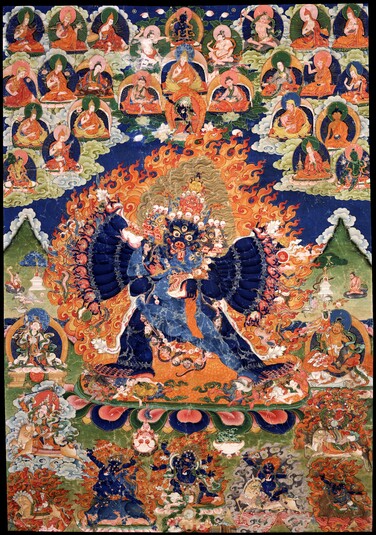
Item: Vajrabhairava (Buddhist Deity) - with consort
| Origin Location | Tibet |
|---|---|
| Date Range | 1800 - 1899 |
| Lineages | Gelug |
| Material | Ground Mineral Pigment on Cotton |
| Collection | Tibet House, New York |
Classification: Deity
Appearance: Animal-Feature
Gender: Male
Vajrabhairava, Father-Mother (Tibetan: dor je jig je, yab yum. English: Vajra Terror): from the Method-Father class of Anuttarayoga Tantra of the Sarma Tradition.
Dark blue, wrathful in appearance, he has nine faces, thirty-two hands and sixteen legs, embracing the consort Vajra Vetali; surrounded by the flames of wisdom fire.
At the top are various lineage teachers and deities. Along the bottom are the principal protectors of the Gelug Tradition.
Jeff Watt 2-2000
Sadhana Description:
"…Sri Vajra-mahabhairava, dark blue, with nine faces, thirty-four arms and sixteen legs, abiding in pratyalidha posture (right legs bent). Capable of devouring the three worlds, he is shouting 'Haha' and has rolled up tongue, bared fangs and a frown. Beside the frown, his eyebrows and eyes blaze like the fire at the time of destruction. His pale yellow hair streams upwards. Threatening the worldly and supermundane gods, he terrifies even the terrible, roaring like thunder the great sound of PHEM and eating human blood, grease, marrow and fat. He is crowned with the five frightful dry skulls and adorned with a skull garland of fifty fresh heads, a black snake as sacred thread, a circlet of human bone. He is naked of body, with a huge belly. His sex stands erect. His eyebrows, eyelashes, beard and body hairs blaze like the fire at the end of time.
His principal face is a buffalo's, black, extremely wrathful and with sharp horns. Above this, midway between the two horns, is a red face, most frightful, with blood dripping from its mouth. Above this is the yellow face of Manjushri, just a little wrathful, adorned with the ornaments of a young man, with five locks on the crown of his head. The main face under the right horn is blue, that to its right red, and that to its left yellow. The main face under the left horn is white, that to its right smoke-colored, and that to its left black. These faces are extremely wrathful. All nine faces are three-eyed.
The first pair of arms hold a fresh elephant-skin, stretched out with its head on the right and hands and feet on the left, showing the hairs outside. The remaining right hands hold a knife, a dart, a wooden pestle, a knife with wavy blade, a harpoon, an axe, a spear, an arrow, a hook, a club, a katvanga, a wheel, a five-pointed vajra, a vajra hammer, a sword and a damaru. The left hold a blood-filled skull, Brahma's head, a shield, a foot, a noose, a bow, entrails, a bell, a hand, a shroud, a man impaled on a stake, a brazier, a piece of a skull, a threatening forefinger, a triple bandarole and a fan.
His right feet tread on a human being, a buffalo, an ox, an ass, a camel, a dog, a sheep and a fox; his left feet on a vulture, an owl, a raven, a parrot, a hawk, a garuda, a domestic fowl and a swan. He also tramples beneath his feet Brahma, Indra, Visnu, Rudra, Six-faced Kumara, Vanayaka, Candra and Surya, lying face down. In this manner he abides amid an intensely blazing mass of fire.
In his lap is the Mother, Vajra-vetali, blue, with one face and two arms, her right hand brandishing a vajra knife and her left holding a skull full of the blood of the vicious and embracing the Father. She is crowned with five dry skulls, has a long necklace of fifty, also dry, and is adorned with the five symbolic ornaments. Her right leg is extended, her left left embraces the Father.
From Deities of Tibetan Buddhism, Wisdom Publications, 2000. Translated by Martin Willson from the sadhana text of Phabongkha Dechen Nyingpo (1878-1941): biographical reference.
Collection of Tibet House: New York (Repatriation)
Tradition: Gelug Deity Paintings
Buddhist Deity: Vajrabhairava Main Page
Buddhist Deity: Vajrabhairava & Gelug Protectors Composition
